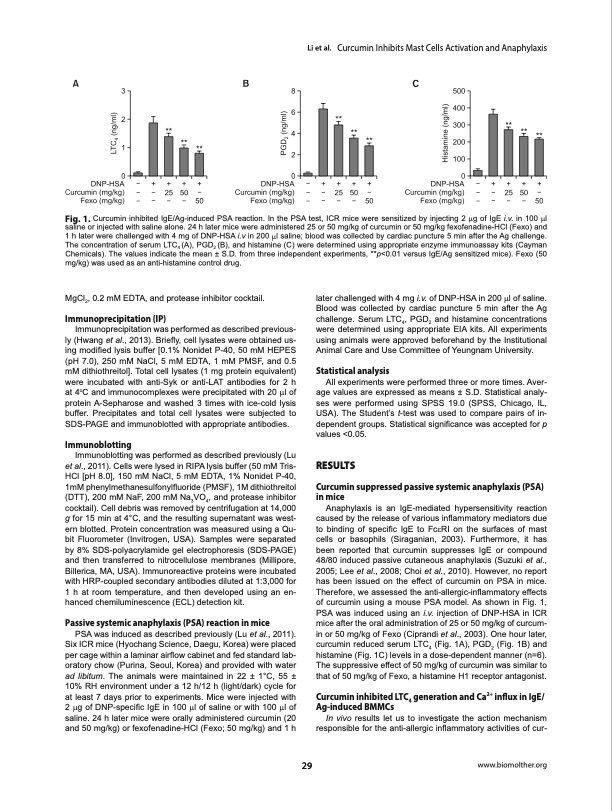
PDF Publication Title:
Text from PDF Page: 003
Li et al. Curcumin Inhibits Mast Cells Activation and Anaphylaxis Fig. 1. Curcumin inhibited IgE/Ag-induced PSA reaction. In the PSA test, ICR mice were sensitized by injecting 2 mg of IgE i.v. in 100 ml saline or injected with saline alone. 24 h later mice were administered 25 or 50 mg/kg of curcumin or 50 mg/kg fexofenadine-HCl (Fexo) and 1 h later were challenged with 4 mg of DNP-HSA i.v in 200 ml saline; blood was collected by cardiac puncture 5 min after the Ag challenge. The concentration of serum LTC4 (A), PGD2 (B), and histamine (C) were determined using appropriate enzyme immunoassay kits (Cayman Chemicals). The values indicate the mean ± S.D. from three independent experiments, **p<0.01 versus IgE/Ag sensitized mice). Fexo (50 mg/kg) was used as an anti-histamine control drug. MgCl2, 0.2 mM EDTA, and protease inhibitor cocktail. Immunoprecipitation (IP) Immunoprecipitation was performed as described previous- ly (Hwang et al., 2013). Briefly, cell lysates were obtained us- ing modified lysis buffer [0.1% Nonidet P-40, 50 mM HEPES (pH 7.0), 250 mM NaCl, 5 mM EDTA, 1 mM PMSF, and 0.5 mM dithiothreitol]. Total cell lysates (1 mg protein equivalent) were incubated with anti-Syk or anti-LAT antibodies for 2 h at 4oC and immunocomplexes were precipitated with 20 ml of protein A-Sepharose and washed 3 times with ice-cold lysis buffer. Precipitates and total cell lysates were subjected to SDS-PAGE and immunoblotted with appropriate antibodies. Immunoblotting Immunoblotting was performed as described previously (Lu et al., 2011). Cells were lysed in RIPA lysis buffer (50 mM Tris- HCl [pH 8.0], 150 mM NaCl, 5 mM EDTA, 1% Nonidet P-40, 1mM phenylmethanesulfonylfluoride (PMSF), 1M dithiothreitol (DTT), 200 mM NaF, 200 mM Na3VO4, and protease inhibitor cocktail). Cell debris was removed by centrifugation at 14,000 g for 15 min at 4°C, and the resulting supernatant was west- ern blotted. Protein concentration was measured using a Qu- bit Fluorometer (Invitrogen, USA). Samples were separated by 8% SDS-polyacrylamide gel electrophoresis (SDS-PAGE) and then transferred to nitrocellulose membranes (Millipore, Billerica, MA, USA). Immunoreactive proteins were incubated with HRP-coupled secondary antibodies diluted at 1:3,000 for 1 h at room temperature, and then developed using an en- hanced chemiluminescence (ECL) detection kit. Passive systemic anaphylaxis (PSA) reaction in mice PSA was induced as described previously (Lu et al., 2011). Six ICR mice (Hyochang Science, Daegu, Korea) were placed per cage within a laminar airflow cabinet and fed standard lab- oratory chow (Purina, Seoul, Korea) and provided with water ad libitum. The animals were maintained in 22 ± 1°C, 55 ± 10% RH environment under a 12 h/12 h (light/dark) cycle for at least 7 days prior to experiments. Mice were injected with 2 mg of DNP-specific IgE in 100 ml of saline or with 100 ml of saline. 24 h later mice were orally administered curcumin (20 and 50 mg/kg) or fexofenadine-HCl (Fexo; 50 mg/kg) and 1 h later challenged with 4 mg i.v. of DNP-HSA in 200 ml of saline. Blood was collected by cardiac puncture 5 min after the Ag challenge. Serum LTC4, PGD2 and histamine concentrations were determined using appropriate EIA kits. All experiments using animals were approved beforehand by the Institutional Animal Care and Use Committee of Yeungnam University. Statistical analysis All experiments were performed three or more times. Aver- age values are expressed as means ± S.D. Statistical analy- ses were performed using SPSS 19.0 (SPSS, Chicago, IL, USA). The Student’s t-test was used to compare pairs of in- dependent groups. Statistical significance was accepted for p values <0.05. RESULTS Curcumin suppressed passive systemic anaphylaxis (PSA) in mice Anaphylaxis is an IgE-mediated hypersensitivity reaction caused by the release of various inflammatory mediators due to binding of specific IgE to FcεRI on the surfaces of mast cells or basophils (Siraganian, 2003). Furthermore, it has been reported that curcumin suppresses IgE or compound 48/80 induced passive cutaneous anaphylaxis (Suzuki et al., 2005; Lee et al., 2008; Choi et al., 2010). However, no report has been issued on the effect of curcumin on PSA in mice. Therefore, we assessed the anti-allergic-inflammatory effects of curcumin using a mouse PSA model. As shown in Fig. 1, PSA was induced using an i.v. injection of DNP-HSA in ICR mice after the oral administration of 25 or 50 mg/kg of curcum- in or 50 mg/kg of Fexo (Ciprandi et al., 2003). One hour later, curcumin reduced serum LTC4 (Fig. 1A), PGD2 (Fig. 1B) and histamine (Fig. 1C) levels in a dose-dependent manner (n=6). The suppressive effect of 50 mg/kg of curcumin was similar to that of 50 mg/kg of Fexo, a histamine H1 receptor antagonist. Curcumin inhibited LTC4 generation and Ca2+ influx in IgE/ Ag-induced BMMCs In vivo results let us to investigate the action mechanism responsible for the anti-allergic inflammatory activities of cur- 29 www.biomolther.orgPDF Image | Curcumin Inhibits the Activation of Immunoglobulin

PDF Search Title:
Curcumin Inhibits the Activation of ImmunoglobulinOriginal File Name Searched:
curcumin-mast-cells.pdfDIY PDF Search: Google It | Yahoo | Bing
CO2 Organic Rankine Cycle Experimenter Platform The supercritical CO2 phase change system is both a heat pump and organic rankine cycle which can be used for those purposes and as a supercritical extractor for advanced subcritical and supercritical extraction technology. Uses include producing nanoparticles, precious metal CO2 extraction, lithium battery recycling, and other applications... More Info
Heat Pumps CO2 ORC Heat Pump System Platform More Info
| CONTACT TEL: 608-238-6001 Email: greg@infinityturbine.com | RSS | AMP |